Alps plane crash: What we know so far
The co-pilot of a Germanwings flight that crashed into the French Alps sent the plane into its doomed descent "intentionally", French investigators have said.
He was alone in the cockpit when he initiated the plane's dive and refused to allow the captain back through the cockpit door, Marseille prosecutor Brice Robin revealed.The German A320 Airbus flight 4U952 from Barcelona to Duesseldorf came down in a remote mountain valley in France on Tuesday 24 March, killing all 150 people on board.

What happened?
The plane took off from Barcelona at 09:01 GMT on 24 March. Reports from Flightradar24, which tracks air traffic around the world, said the Airbus climbed to 38,000ft within the next half hour.
At 09:30 the plane made its final contact with air traffic control - a routine message about permission to continue on its route.
One minute later it began to descend. The descent lasted nearly ten minutes before last radar contact with the Airbus at 09.40:47.
The Airbus crashed in a remote, snow-covered mountainous region - some parts reaching about 6,500ft high - and inaccessible by road.
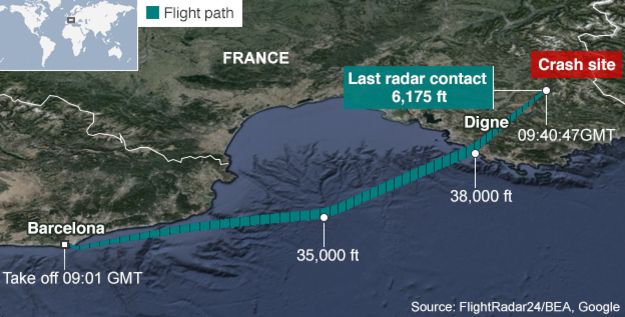
On 26 March, French investigators said information from the cockpit voice recorder revealed that co-pilot Andreas Lubitz had taken over the controls of the plane and sent it into a dive intentionally.
The captain had left to answer a "call of nature", leaving Mr Lubitz in sole control. At this point, the co-pilot activated the plane's descent.
It was Mr Lubitz's "intention to destroy this plane," Marseille prosecutor Brice Robin said.
The cockpit voice recorder, discovered at the crash site, has given investigators details of the first 30 minutes of the flight.
For the first 20 minutes, the two pilots talked normally, prosecutors said, then the captain is heard asking the co-pilot to take over. The sound of a chair being pushed back can be heard followed by a door being closed.
Then, during the final minutes of the flight's descent, pounding can be heard on the door as the captain tried desperately to get back into the cockpit. Alarms also sounded.
While the co-pilot did not say a word after the commanding pilot left, his breathing could be detected, indicating he was still alive at the time of the impact, Mr Robin said.
Prosecutors said there was no reason to suspect a terrorist attack.
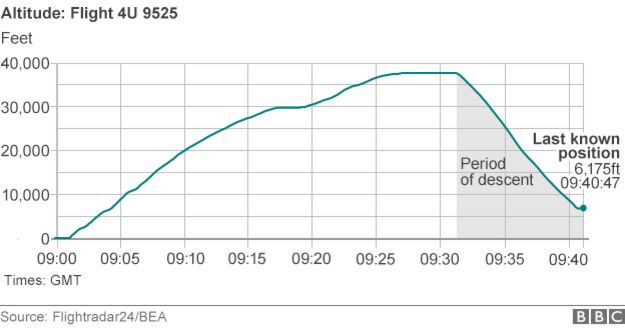
Flightradar24 said the airbus was descending at a rate of about 3-4,000ft per minute, which, it said, was standard for an airport approach.
The plane hit the ground at high speed and the nature of its remains suggest it did not break up before impact.


'Black boxes'
The plane's cockpit voice recorder - one of its two "black boxes" - was retrieved from the crash zone, although in battered condition. The second box, recording technical data, has not yet been located.
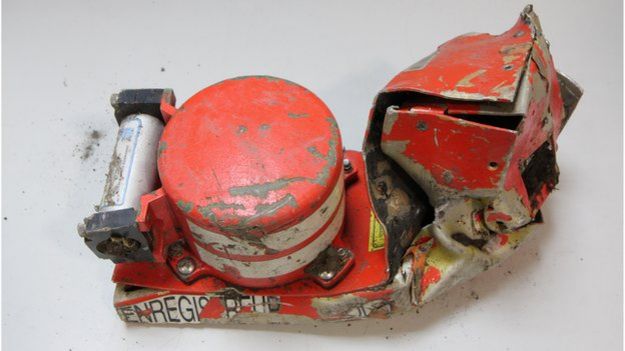
An aircraft's flight recorders are often the key to establishing what caused a plane to crash. Each plane carries two recorders: the cockpit voice recorder (CVR) and the flight data recorder (FDR). Although they are popularly known as black box recorders, they are, in fact, orange to aid in recovery.
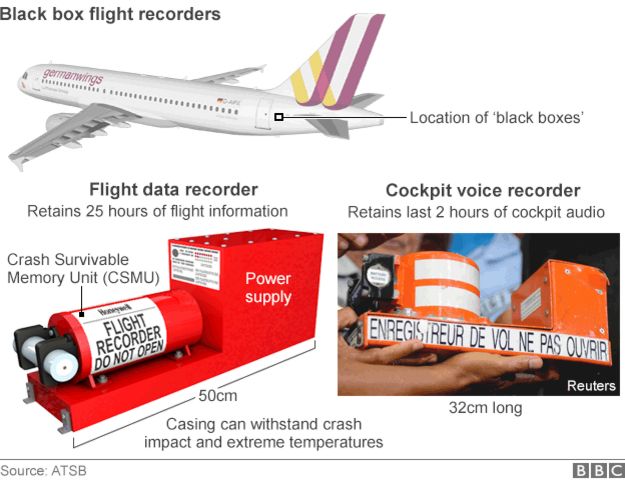
The CVR, as the name suggests, records the voices of the pilots and other sounds from the cockpit.
It retain two hours of recording - on longer flights, the latest data is recorded over the oldest. On some older models, magnetic tape is still used for the recording, but newer models use memory chips.
The FDR records technical flight data, including at least five basic sets of information: pressure altitude, airspeed, heading, acceleration and microphone keying (the time radio transmissions were made by the crew).
The FDR retains the last 25 hours of aircraft operations and, like the CVR, data is recorded on an endless loop.
Both recorders are designed to withstand a massive impact and a fire reaching temperatures up to 1,100C for 60 minutes.
Debris zone
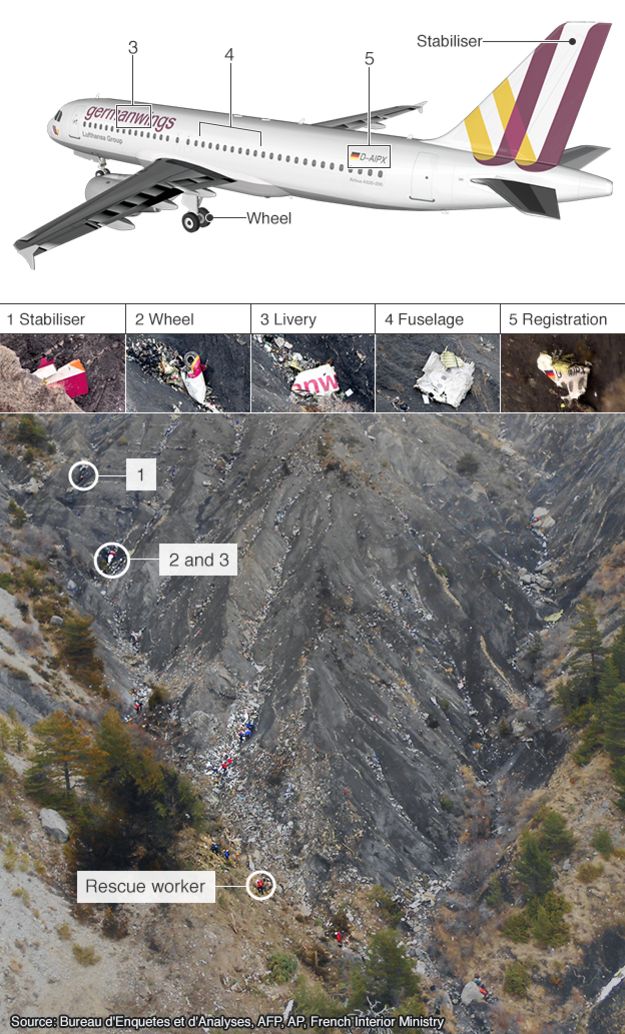
Helicopters are continuing to search the crash site. There is no access by foot and the search teams are being winched down from the aircraft.
A local council official, Gilbert Sauvan, said the debris was spread over a wide area and that everything was "pulverized". The largest pieces of debris are said to be the size of a small car.
A number of police and civil security helicopters have been deployed to the area and about 300 police, and a similar number of firefighters from surrounding regions, have been sent to assist local crews.
A temporary mortuary has been set up in the sports hall of the nearby town of Seyne-les-Alpes, from where many of the rescue teams have also been despatched.The aircraft
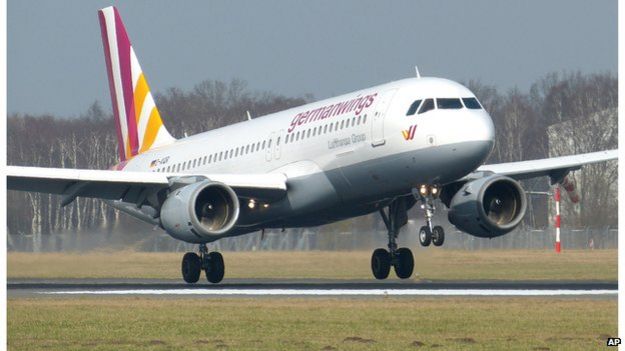
The plane is one of the oldest A320s in operation. It entered service for the German airline in 1991.
It had passed a routine maintenance check only the day before the flight.
Co-pilot Andreas Lubitz, 28, joined Germanwings in September 2013, directly after training, and had flown 630 hours.
Lufthansa said the captain had more than 6,000 hours of flying experience and had been with Germanwings since May 2014, having flown previously for Lufthansa and Condor.
Lufthansa said its cockpit protocols are in line with rules established by the German aviation safety authority. These stipulate that when there are two crew, one can leave the cockpit but only for the absolute minimum time.
Who was on on board?

There were 144 passengers on board the plane, four cabin crew and two more crew in the cockpit.
Germanwings officials said victims included 72 German nationals, among them 16 school students. The Spanish authorities say there were 51 Spaniards.
Other victims were from Australia, Argentina, Britain, Iran, Venezuela, the US, the Netherlands, Colombia, Mexico, Japan, Denmark and Israel.
Comments
Post a Comment